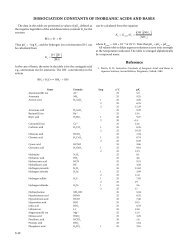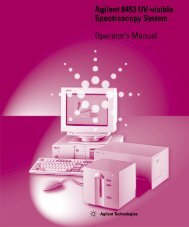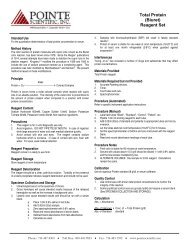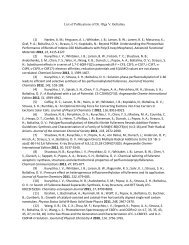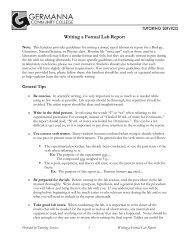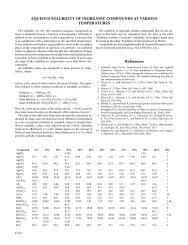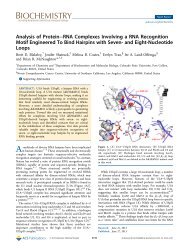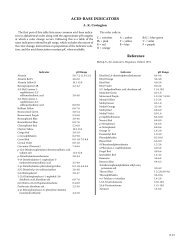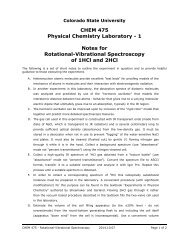Calibration of Volumetric Glassware - Colorado State University
Calibration of Volumetric Glassware - Colorado State University
Calibration of Volumetric Glassware - Colorado State University
You also want an ePaper? Increase the reach of your titles
YUMPU automatically turns print PDFs into web optimized ePapers that Google loves.
<strong>Calibration</strong> <strong>of</strong> <strong>Volumetric</strong> <strong>Glassware</strong> CHEM 334 Quantitative Analysis Laboratory from the pipet must be carefully controlled so as to leave a uniform and reproducible film along the inner glass surface. Measuring Pipets will be gradated in appropriate units. Once the pipet is cleaned and ready to use, make sure the outside <strong>of</strong> the tip is dry. Then rinse the pipet with the solution to be transferred. Insert the tip into the liquid to be used and draw enough <strong>of</strong> the liquid into the pipet to fill a small portion <strong>of</strong> the bulb. Hold the liquid in the bulb by placing your fore finger over the end <strong>of</strong> the stem. Withdraw the pipet from the liquid and gently rotate it at an angle so as to wet all portions <strong>of</strong> the bulb. Drain out and discard the rinsing liquid. Repeat this once more. To fill the pipet, insert it vertically in the liquid, with the tip near the bottom <strong>of</strong> the container. Apply suction to draw the liquid above the graduation mark. Quickly place a forefinger over the end <strong>of</strong> the stem. Withdraw the pipet from the liquid and use a dry paper to wipe <strong>of</strong>f the stem. Now place the tip <strong>of</strong> the pipet against the container from which the liquid has been withdrawn and drain the excess liquid such that the meniscus is at the graduation mark. Figure 5. Pipet Usage Move the pipet to the receiving container and allow the liquid to flow out (avoiding splashing) <strong>of</strong> the pipet freely. When most <strong>of</strong> the liquid has drained from the pipet, touch the tip to the wall <strong>of</strong> the container until the flow stops and for an additional count <strong>of</strong> ten. <strong>Volumetric</strong> Flasks. The volumetric flask is used to prepare Standard Solutions or in diluting a sample. Most <strong>of</strong> these flasks are calibrated To-‐Contain (TC) a given volume <strong>of</strong> liquid. When using a flask, the solution or solid to be diluted is added and solvent is added until the flask is about two-‐thirds full. It is important to rinse down any solid or liquid that has adhered to the neck. Swirl the solution until it is thoroughly mixed. Now add solvent until the meniscus is at the calibration mark. If any droplets <strong>of</strong> solvent adhere to the neck, use a piece <strong>of</strong> tissue to blot these out. Stopper the flask securely and invert the flask at least ten times. Burets. The Buret is used to accurately deliver a variable amount <strong>of</strong> liquid. Fill the buret to above the zero mark and open the stopcock to fill the tip. Work air bubbles out <strong>of</strong> the tip by rapidly squirting the liquid through the tip or tapping the tip while solution is draining. The initial buret reading is taken a few seconds, ten to twenty, after the drainage <strong>of</strong> liquid has ceased. Holding a white piece <strong>of</strong> paper with a heavy black mark on behind the buret can highlight the meniscus. Place the flask into which the liquid is to be drained on a white piece <strong>of</strong> paper. (This is done during a titration to help visualize color changes that occur during the titration.) The flask is swirled with the right-hand while the stopcock is manipulated with the left-‐ hand. The buret is opened and allowed to drain freely until near the point where liquid will no longer be added to the flask. Smaller additions are made as the end-‐point <strong>of</strong> the addition is neared. Allow a few seconds after closing the stopcock before making any readings. At the end-‐point, read the buret in a manner similar to that above. <strong>Colorado</strong> <strong>State</strong> <strong>University</strong> 2014.09.08 Page 3 <strong>of</strong> 6




